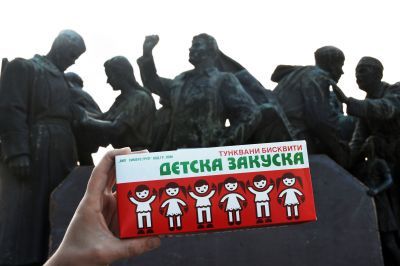Communist consumer goods make comeback

Once the butt of jokes the world over, communist-era East European goods from sweets, to rustic washing machines and clunky cars are all the rage again.
As the world prepares to mark the 20th anniversary of the fall of the Berlin Wall, souvenirs such as portraits of Romanian leader Nicolae Ceausescu are now avidly sought at markets. In Belgrade, cafes are named after Yugoslav leader Josip Broz Tito or even the Soviet KGB secret police.
Two decades on, many who then welcomed change now want to turn the clock back by eating Szerencsi chocolate, driving Trabant two-stroke cars or using Frania washing machines to wash carrots.
Nothing is too tacky, the quality never too questionable. For older people there is the nostalgia of the bad old days. Among younger people there is a curiosity to find out how their parents lived.
Many food brands have made a comeback on supermarket shelves using the same packaging that made them look so old fashioned and unwanted between 1945 and 1990.
"For a few years now there has been a tendency to bring back brands from the communist era. It makes us feel nostalgic, reminds us of our youth," said Romanian sociologist Mircea Kivu.
"These products remind me of my childhood. I would much rather eat a Szerencsi chocolate bar than a Mars," said Tamas Pickarczyk, a 27-year-old car salesman in Budapest.
"In my opinion Szerencsi tastes better. It is better quality but most of all it brings back good memories."
Bulgarian student Ivan Petrov said packaging gave totalitarian-era products their charm. "I love Detska-Zakouska biscuits for their flavour and their communist packaging."
In Croatia, the savoury spread Vegeta is still a staple across all the countries of the former Yugoslavia.
Soviet bloc machinery had a reputation worse than the food, but it is also kept alive by die-hard fans, even making a profit in some cases.
In Poland the Rotor Frania washing machine was a communist housewife's dream from the 1950s to the 1970s. The user had to pour water in and drain it manually but it had it is own rotor mechanism to clean the clothes.
"Although the manual machines have been replaced by automatic ones, the Frania still continues to sell at a rate of about 40,000 units per year," according to Magda Kwiatkowska, a sales manager for the Emalia Olkusz company which makes them.
Many farmers still use the 100 euro (dollar) machine to turn butter, clean carrots and even produce home-made alcohol, as well as wash their clothes.
Many car brands also date from the communist era.
The old joke ran that the best way to increase the value of a Skoda, made in the old Czechoslovakia, was to fill up the petrol tank. Now it is thriving as part of the Volkswagen empire.
In Romania, 42 years after its launch the Dacia car remains the best known make. Even though the company has been taken over by French maker Renault, market studies indicated that Romanians wanted to keep the Dacia name from the era of Nicolae Ceausecu's dictatorship, said Kivu, the sociologist.
The Trabant used to be the most popular car in East Germany where now several associations keep the remaining models alive for future generations.
In Poland, loyal users of the Polski Fiat 126 organise several rallies a year to tell mythical stories of how they used to get four people plus bags into the tiny cars.
Among other Polski Fiat myths, a pair of tights could easily replace a broken fan belt, if you were lucky enough to have a spare pair of tights in such austere times.
Subscribe to Independent Premium to bookmark this article
Want to bookmark your favourite articles and stories to read or reference later? Start your Independent Premium subscription today.

Join our commenting forum
Join thought-provoking conversations, follow other Independent readers and see their replies